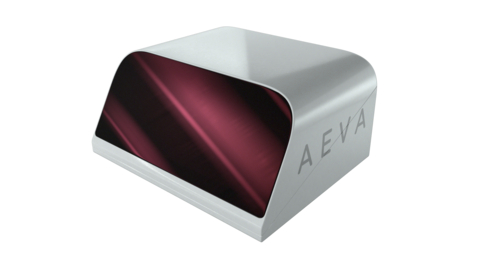Aeva Introduces Aeries II – The World’s First 4D LiDAR with Camera-Level Resolution
Aeva (NYSE: AEVA) announced the launch of its next-generation Aeries™ II 4D LiDAR sensor designed for automotive and industrial applications. The sensor detects instantaneous velocity in addition to 3D positioning, powered by Aeva’s FMCW technology. Key features include Ultra Resolution imaging with up to 1000 lines per frame and LiDAR-on-Chip technology, significantly enhancing sensor integration and performance.
Aeries II, available mid-2022, aims to improve safety and automation across various industries.
- Launch of Aeries II 4D LiDAR enhances perception capabilities by measuring instantaneous velocity.
- Features Ultra Resolution imaging with up to 1000 lines per frame, improving detection range and accuracy.
- LiDAR-on-Chip technology promotes reliable and scalable manufacturing.
- Designed with automotive-grade reliability to perform under various environmental conditions.
- Compact size allows for versatile integration in automotive and industrial applications.
- Dependent on successful commercialization for revenue generation.
- Face competition in a rapidly evolving technology sector that could impact market share.
- Requires continuous capital for growth and innovation in a capital-intensive field.
Insights
Analyzing...
Next-generation FMCW LiDAR Sensor with Advanced 4D Perception Software Detects Instant Velocity in Addition to Position, with Automotive Grade Reliability in a Compact Form Factor and Up to 1000 Lines Per Frame with Ultra Resolution™ to Enable the Next Wave of Autonomy

- Camera-Level Ultra Resolution: Leverages Aeva’s proprietary raw 4D data to deliver a real-time camera-level image with up to 1000 lines per frame with no motion blur for the static scene
- Instant Velocity with Ultra Long Range: Aeva’s next-generation 4D LiDAR uniquely measures instantaneous velocity for each pixel in addition to 3D position, allowing automated vehicles and machines to perceive where things are and know precisely how fast they are moving, at distances up to 500 meters
- LiDAR-on-Chip Technology: A groundbreaking design eliminates all fiber optics and incorporates all key LiDAR elements onto silicon photonics in a single compact module for reliable and scalable production
- Automotive Grade Reliability: With automotive-grade ratings for ingress, impact, thermal, and shock and vibration to ensure peak performance across a variety of road and environmental conditions
- Designed for Versatility: At a quarter of the size of the previous generation, the compact design allows for a wide range of integration options, with real-time configurable maximum ranges, field of views and scan patterns to enable a broad range of autonomous applications
“Aeries II is a leap forward for the industry, and we believe it will play a critical role in unlocking the next wave of automation across a variety of applications from automotive, to industrial and beyond,” said
Advanced 4D
Aeva’s proprietary perception software leverages raw 4D sensor data to deliver new real-time capabilities not possible with legacy time of flight LiDAR sensors:
- Ultra Resolution: A real-time camera-level image of the world with up to 1000 lines per frame with no motion blur for the static scene, providing up to 20 times the resolution of legacy time of flight LiDAR sensors. Image segmentation enables the detection of roadway markings, drivable regions, vegetation, road barriers, as well as detecting road hazards like tire fragments at up to twice the distance of legacy time of flight LiDAR sensors. Instant velocity data allows for high confidence detection and tracking of dynamic objects such as oncoming vehicles and other moving objects at distances up to 500 meters.
- 4D Localization: Per point velocity data enables real-time ego vehicle motion estimation with six degrees of freedom, motion compensation, and on-line sensor extrinsic calibration to aid with sensor fusion. These vehicle estimation features also enable accurate vehicle positioning and navigation without the need for additional sensors, like IMU or GPS, making autonomous navigation in GPS-denied and featureless environments like tunnels possible.
“The improved safety, efficiency, and sustainability of our autonomous trucks are good for fleets, for the public, and for the environment,” said
Instant Velocity Detection with Ultra Long Range Performance
Using Aeva’s FMCW 4D technology, Aeries II delivers breakthrough performance by directly measuring the velocity of each point with centimeter per second precision, in addition to precise 3D position. Delivering four million raw points per second, a maximum field of view of 120 degrees by 30 degrees, and a maximum detection range of up to 500 meters, Aeries II holds unique advantages that allow vehicles and industrial machines to operate at higher levels of automation across a broad set of conditions, including:
- Elimination of retroreflector blooming and ghosting from highly reflective objects like street signs and roadway markings, ensuring optimal performance in complex road environments where reflective markers and signs degrade legacy LiDAR sensor performance.
- Greater ability to see through airborne particulates like dust, fog, rain, and snow, allowing improved sensor performance across a broad set of environmental conditions.
-
Freedom from interference from other LiDAR sensors, including
Aeva sensors, providing clear perception when operating near other LiDAR-equipped vehicles. - Freedom from interference from the sun when it is in the field of view of the sensor, such as during sunrise and sunset, ensuring sensor performance across a wider set of lighting conditions.
The World’s First LiDAR-on-Chip Technology
Aeva’s groundbreaking LiDAR-on-Chip design eliminates all fiber optics and places all key components including transmitters, receivers and optics onto a silicon photonics chip in a compact module. This design, unique to Aeva’s FMCW 4D technology, enables the manufacturing process to be fully automated, allowing
Automotive Grade Reliability
Aeries II is built for reliability with automotive-grade ratings to ensure peak performance across a variety of road and environmental conditions. Robust IP67 ingress and IK07 impact ratings protect the sensor from dust, water and other particles. Aeries II is also designed to meet the reliability requirements of ISO 16750 standards to ensure durability throughout operation.
Designed for Versatility
The compact design is
Availability
Aeries II will be available starting mid-2022. To learn more visit www.aeva.com/aeries-ii.
AEVA Product & Technology Day
Aeries II was unveiled by
About
Aeva’s mission is to bring the next wave of perception to a broad range of applications from automated driving to industrial robotics, consumer electronics, consumer health, security and beyond.
Forward looking statements
This press release contains certain forward-looking statements within the meaning of the federal securities laws. These forward-looking statements generally are identified by the words “believe,” “project,” “expect,” “anticipate,” “estimate,” “intend,” “strategy,” “future,” “opportunity,” “plan,” “may,” “should,” “will,” “would,” “will be,” “will continue,” “will likely result,” and similar expressions. Forward-looking statements are predictions, projections and other statements about future events that are based on current expectations and assumptions and, as a result, are subject to risks and uncertainties. Many factors could cause actual future events to differ materially from the forward-looking statements in this press release, including, but not limited to: (i) the ability to maintain the listing of Aeva’s securities on the
View source version on businesswire.com: https://www.businesswire.com/news/home/20220201005588/en/
Media:
press@aeva.ai
Investors:
investors@aeva.ai
Source:







